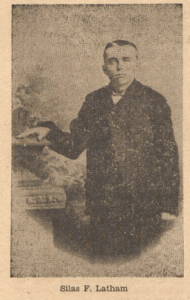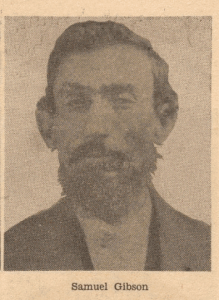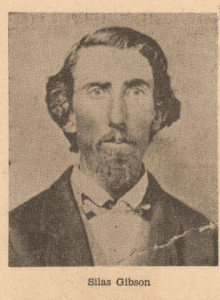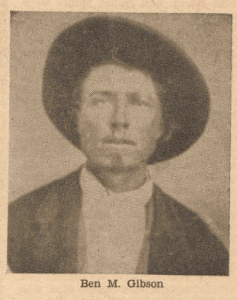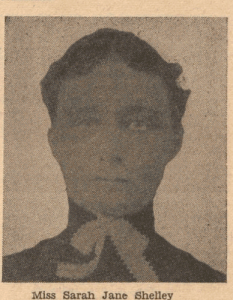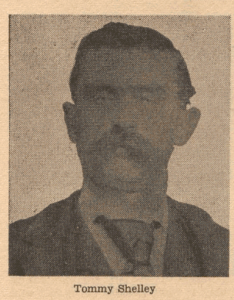By using our website, you agree to the use of cookies as described in our Cookie Policy
Joseph Young Latham, Early Day School Teacher - Miss Rina Latham
[From J. Marvin Hunter's Frontier Times Magazine, December, 1949]
Joseph Young Latham, (familiarly known as Dode Latham), was born in Blanco county, Texas, February 22, 1865, on Spring Creek, near the junction of Spring Creek and White Oak Creek. His parents were Mr. and Mrs. G. W. A. Latham, who for many years lived in Blanco and Llano counties during the strenuous days for the pioneers, when the marauding Indians infested the country, as well as the screaming panther and howling wolves. His parents soon moved from this home on Spring Creek to a location on Wright's Creek, about five miles to the northwest, where they lived for some time. Here the Comanche Indians often made raids and stole their stock. One day, I believe it was the 4th of July, a horse came dashing in from the pasture with an Indian's lariat around its neck, convincing my mother that the Indians were in the vicinity stealing horses. This horse belonged to a negro boy about 13 years old, who ran out and caught the horse and tied it up. Mother knew the situation was grave, and she called her six little children into the house, and donned man's clothing. She shouldered her Enfield rifle and walked about the yard so that the Indians would think there was at least one man on the place.
On another occasion my father, G. W. A. Latham, had some horses near the house, and he and Uncle Ben Gibson, a noted Indian fighter, were watching these horses when they saw Indians approaching. They were looking through a port hole, and in the bright moonlight could see very plainly the movements of the redskins. They shot at the Indian, but Father's gun snapped. He made quick adjustment and they shot again, when the Indians quickly mounted and rode away. The children counted them and Brother Jim said there were fifteen of the red rascals.
The Indians visited this place so often that my father decided to move his family to the Pecan Creek neighborhood, near the families of John Backues and Ben Phillips. I remember one great event which happened at this place: Our uncle, Silas Gibson, who had moved from Missouri to California shortly after the gold strike, 1850, to join his brother, Samuel Gibson, came to Texas where his father and a number of relatives were living. He and his brother had become very wealthy farming in the Golden State, alfalfa being the chief crop they raised, and he came to Texas to buy cattle to drive back to California. Father was a well-to-do stockman at that time, and sold him several hundred head. Uncle Silas wanted his relatives to go back to California with him, and his brother-in-law, Robert Hardin, and sister, Deborah, and daughter, Effie, and Mrs. Hardin's children, by a former marriage, Lee and Melissa Phillips; also his brother, Joe Gibson and family, Tommie Shelly, and Brother Eli, accompanied him on the return trip. There were several other cowmen, with women and children in ox-wagons, making quite a party. They left the old ranch May 1, 1869. Besides his father and sister, Mrs. G. W. A. Latham, he had to leave his heart with one of the finest ladies who ever lived in that county, Miss Jane Shelly, but he promised to return for her the next year.
They traveled from Llano county, up to Fort Concho, then up the Centralia Draw, down through Castle Gap, to the Pecos river, and up that stream for several days, when they were attacked by a large band of Indians, who stampeded their horses and cattle and fought with the men at the wagons. This was where Ben Gibson killed his first Indian. Silas Gibson, who’d traveled from Missouri to California and back to Texas by way of Cape Horn, was an experienced Indian fighter and frontiersman. He followed some of the Indians who had gotten off with their stock, and when he caught up with them he dismounted from his horse to fight them and was killed by the savages, who terribly mutilated his body. While the Indians were attacking the wagons, my aunt, Mrs. Joe Gibson, stood where the men could hear her voice, and encouraged them by shouting, "Fight them, boys; don't give up."
They recovered Uncle Silas Gibson's body, and buried him near the mouth of Black Creek, on the Pacos river. Miss Jane Shelly lives near Fredericksburg, Texas, now, and has almost reached the century mark, waiting the coming of the Lord. These hardy pioneers, despite their reverses, did not turn back, but continued on their way to Stockton, California.
Ben M. Gibson and Eli Shelly, Tommy's brother, did not remain in California long. They came back via San Francisco to Chicago, then down the Mississippi to New Orleans and across to Galveston. Shortly after Uncle Ben reached home he went on an Indian scout on his favorite horse, Patty, and on this scout he killed an Indian. Uncle Ben was always ready for adventure. He was with some neighbors one day, down on Double Horn Creek, and they found a great hole in the ground. Some of the men bantered Uncle Ben to go down in the hole. He got a large sack, and was let down by his friends. In the bottom he found some harness, clothing and shoes, and dead men's bones. He found two wrists tied together with a handkerchief, and a number of skulls. There was a lot of mystery about that cave, and it was ever afterwards called "Dead Man's Hole." Mrs. Albino Fox, who lives here in New Mexico, visited me recently and she stated that her grandfather, Hoppe, was killed during or shortly after the Civil War and thrown into that hole.
Brother Silas was a small man like Uncle Ben Gibson, and had the same adventurous spirit. One day some cowmen were herding their cattle near Mesquite Hill in Llano county, and they noticed a hole dug out by the side of a rock. Silas and another small boy went down into the hole and brought out six of the ugliest animals I ever saw. They were a cross between a large hound dog and a large female lobo. The boys took home a pup apiece. Silas got one, and I think Leon Haynes got one, and if Thomas Bridges was there I am sure he got one. One of the pups got away. The next Sunday, as Father and I were going to church, this lobo and whelp ran past us and up the road several yards in front of us. Father tried to catch the whelp, but it outran him. Silas was a sickly and unfortunate boy. One day he, Dode, R. L. Tate, and little Brother Willie, were mending a wire fence, when lightning struck the fence and shocked all of them. They started to cross Wright's Creek, and Silas' horse was washed down the creek into a hole, and they had a difficult time getting him out.
In 1869 Dode Latham attended a private school near his home on Pecan Creek. Miss Mary Reams was his first teacher. When he grew older he attended the Cedar Creek school, where the fathers had to guard the children on their way to and from school on account of danger from Indians. M. R. Sheppard, John Haley, and James Moore were some of his first teachers, and Code Phillips also taught school there in the early days. One day a negro boy came by and hollered, "School butter," and as per custom, the boys caught him and ducked him in the creek for his taunt, and almost drowned him. Dode spent many happy days at the old school house. Some of his chums were Damon Slator and Jim Backues. The poem, "Up on the River and Over the Lea," just fits those boys. Their main sports were swimming and fishing until they got old enough to ride horses, then Jim would mount his pony, "Drake," and Dode his little pony named "Rip," and ride them over the prairie. One Sunday they were riding around at the mouth of Pecan Creek, when they came upon a yearling with its tongue cut out. Of course they knew that was an Indian trick, and they did not let much grass grow under their horses' feet until they reached home. Dode had a little sorrel mare, named Dinah. She was very contrary, but a good traveler. It was the custom for the men to have a red blanket rolled up and tied behind their saddle, and one day Dode slipped Mother's red blanket out of the house and tied it on behind his saddle. He mounted and started through a gate but with the blanket as excess baggage, the gate fit Dinah too soon and she wouldn't budge. Mother heard the commotion and came out to investigate, and right there she put a stop to Dode's course of trying to look like Montgomery Phillips or Dever Harrington.
In 1875, my grandfather, Dr. B. G. Latham, and family came to Llano county where we lived. Father had just built a big house and we had a fine time. Grandfather bought a farm on the river and raised lots of good watermelons, which was a great treat to us children.
In the fall of 1881 the Pecan Creek citizens built a new house which was used for school and church purposes. It became known as the Macedonia Baptist church. Here we all went to school, and Dode was always the best scholar in that school. In the fall of 1883 Mr. Lincoln taught singing, along with reading, writing and arithmetic. Dode afterward took over the school and was a good teacher. Five of his sisters and brothers went to school to him. But Dode was a cowboy at heart, so when John C. Tate wanted him to go along with a herd in the spring, Dode resigned his position as teacher of the Pecan Creek school and took to the trail. While he was on this drive with Mr. Tate, an Indian came into camp one night and took Dode's expensive new Stetson hat from Dode's head and replaced it with his old worn-out straw hat. He reached to get it and took a lock of hair, which made Mr. Indian very mad, and when some other Indians began coming, and still others, the situation looked grave, but Dode kept contending for his hat, even though it availed nothing. My older brother, Jim, and the boss tried to get Dode to give up the hat, as they know the Indians would cause trouble — maybe stampede the herd and kill the cowboys, and they finally had to threaten to tie Dode down before he would surrender his hat. I can yet visualize Dode riding around the herd with that old straw hat on and his brown hair protruding through the holes in the hat. The drive continued on to Dodge City, Kansas, and the boys soon re turned home to Llano county.
Campmeeting time soon began at Flat Rock. As was the custom, all stock was turned loose and all the people went to the meetings. Horace Lincoln played the organ and Miss Irene Frances assisted. There were about fifty people converted in one of these meetings. The cowboys would take their bedrolls and sleep in the flats. Dode was among the converts at the meeting.
One day as Dode was clerking at the store at La Vista for Rev. Talley and Mr. Hallford, a young man rode up on a very spirited horse. Dode thought he would go out and ride this horse, which was hitched by a well, and when Dode mounted him, the horse made a lunge and jumped through the pulley frame over the well, and when he hit the ground he was running. He ran about half a mile down a sandy road to the river, and Dode stopped him there. Soon after this we were going to church one day, and I was in the wagon with my parents, and that same horse came running by with Dode on his back. Dode was wearing an old fashioned linen duster, which was flying in the air, and as he passed the wagon he called to me: "Girl, don't you ride this horse any more." He had recently run away with me. Dode clerked in stores until school started and then taught several terms in the Pecan Creek school. The citizens of the Comanche Creek neighborhood built Dode a residence near the Comanche school house so he could teach there, and he taught that school three years. Mr. A. Davis had been the teacher there many years before. He was a very firm man, and one day some of the larger boys disobeyed the rules and he kept them in over night and stayed right there with them. Robert Hardin and the Sugart boys were among those kept in.
On December 11, 1891, Dode was married to Miss Annie Shults of Waters Creek, Llano county. He taught school around through the country until he came to New Mexico in 1897. He made Carlsbad his home and taught school there until he went into the goat business. He went to Oklahoma twice, and each time cyclones wiped him out. Then he tried his luck in South Dakota, but returned to the Sacramento Mountains in New Mexico, and was chief of police in Alamogordo for twelve years. Then he engaged in the mercantile business for a few years, and settled in Alamogordo, where he lived until he died August 8, 1948, at the age of 83 years. He was always jolly and had many friends. He loved to sing, his favorite song being, "Pass Me Not, O Gentle Savior; hear my humble cry. While on others Thou are calling, do not pass me by." He was my playmate and my pal. Many were the races we ran together, foot races and horse races, but he always beat me to the goal. He was my counsellor and guide. I had the privilege of being with him in his last hours, and with his family who cared for him so devotedly and so well. We laid him to rest in a cemetery at the foot of the Sacramento Mountains, where his father, mother and brother, J. B. Latham, and sister, Mollie Hardin, are resting.
"Blessed are those whom the Lord finds watching,
In His glory they shall share;
If He comes at the dawn or midnight
Will He find us watching there?"
‹ Back



